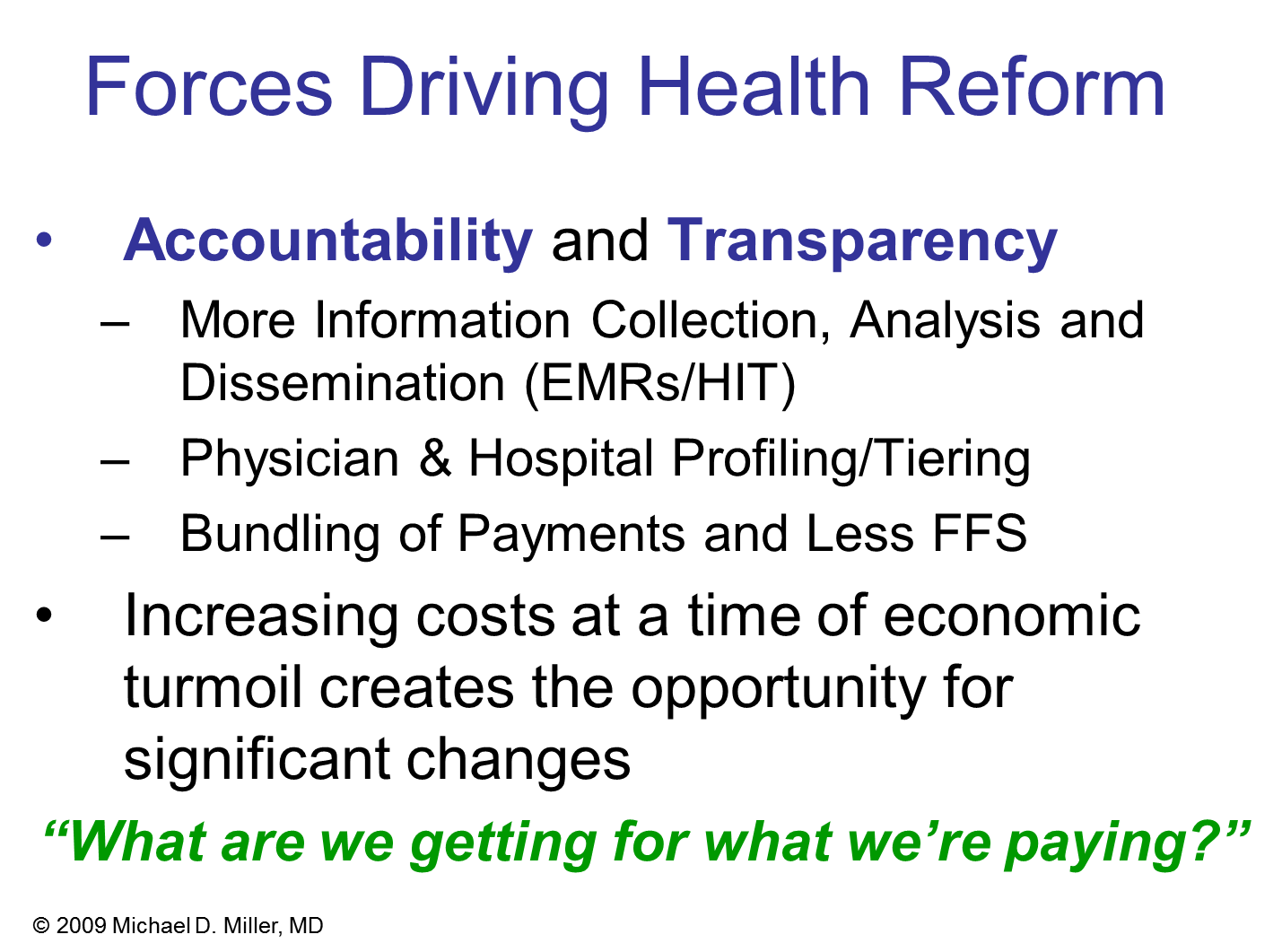At a recent panel on health and education reform Toby Cosgrove, the Cleveland Clinic’s CEO, stated that two of the most important things for improving the US healthcare system are: 1. transparency about quality, and 2. transparency about costs. This reminded me of a March 2009 Grand Rounds presentation I gave at a Boston Hospital titled “Health Reform 2009 and Beyond.” My core message was that Accountability and Transparency are the forces driving health reform because the stakeholders paying for healthcare services and products are focusing on the value-centric question, ”What are we getting for what we’re paying?”
Below is a slide from my presentation that highlights some of the key transparency and accountability factors for practicing physicians.
The first three sub-bullets indicate the progression of transparency from information to reimbursement: First, electronic medical records are the data source for transparency. Second, this information is used to evaluate the performance of clinicians and healthcare institutions – and that information is both being shared with the public and incorporated into the structure of health benefits, e.g., provider tiers with differential co-pays. And third, knowledge about provider performance is being translated into global and bundled payment arrangements that reward quality and value, rather than volume, i.e. less fee-for-service. (The slide’s last bullet also notes that the 2008-09 economic turmoil created the opening for significant changes based upon the political dictum of “not letting a good crisis go to waste.”)
» Data » Knowledge » Results »
Accountability & Transparency: Together Into the Value Gap
Below is an outline of the major factors of accountability and transparency. And following the outline is a discussion of how data and transparency are prerequisites for accountability. That is, without validated data that is available to decision makers, there is only a void – which is often filled with rhetoric such as, “Trust us, we know what we’re doing.” Or,“Of course we’re doing a great job – we’re highly trained/educated professionals.”
- Transparency
- Data (Quality and Costs)
- Structures
- Processes
- Accountability
- Clinical Outcomes
- Individual Level
- Population
- Economic Outcomes
- Individual Level
- Population
- Society
- Clinical Outcomes
“Living is Easy with Eyes Closed, Misunderstanding All You See.”
Strawberry Fields Forever, John Lennon
Structures and Processes Lead to Outcomes
A dramatic difference between today and 10 or 20 years ago is how quickly healthcare data can be collected and analyzed – with better comp00ters, data collection now only takes months rather than years. However, there are still significant lags between the delivery of care and the demonstration of outcomes.¹ Filling this gap is information about processes and structures, which serve as surrogate measures for outcomes because they are available sooner. Checklists are one of these processes – which my old colleague Atul Gawande has done a great job publicizing. Since checklists have been shown to improve quality and reduce costs in an otherwise complex healthcare system, I keep asking, “Why aren’t they used every time someone puts in a central line or performs surgery?” They should be the standard of care.
» Structures » Processes » Outcomes »
Health Reform Promotes Transparency and Accountability
Not surprisingly, the importance of transparency and accountability are embedded across the provisions of two recent health reform laws: the Patient Protection and Affordable Care Act and the HITECH Act. For example, the ACA requires insurers to be more transparent about premium increases. And on the clinical side, an entire matrix of initiatives are linking better data collection, processing, and dissemination to improving quality of care via more integrated structures and processes. Examples of those types of initiatives include the Beacon program from HHS’ ONC, various medical homes initiatives, and CMS’ Accountable Care Organization/Shared Savings programs.
These programs are all stones in the bridge being built – with aligned public and private partners – that is leading to higher quality care. And Toby Cosgrove noted – and I completely agree – the US is just at the beginning of health reform. Over the next 10 years there will be significant changes in the delivery and financing systems through market, legislative, and regulatory changes.
If the incentives for demonstrating value and outcomes through greater transparency and accountability continues, we will have increasing efficiency, quality, and patient-centeredness in US healthcare delivery and financing. And if not……?
1. The delay between the delivery of care and demonstrating outcomes happens because collecting and analyzing data for a defined population takes time and there is a time lag between the delivery of the care and the observation of the clinical outcome. For example, how well an arthritis treatment regimen improves function and reduces pain needs to be examined over months or years. A farming analogy would be assessing the effects of a new fertilizer or planting method – germination rates or growth velocity can be measured early, but it takes time to determine the final crop yield or quality.

“The delay between the delivery of care and demonstrating outcomes happens because collecting and analyzing data for a defined population takes time and there is a time lag between the delivery of the care and the observation of the clinical outcome”
I strongly agree with this, takes time for better results